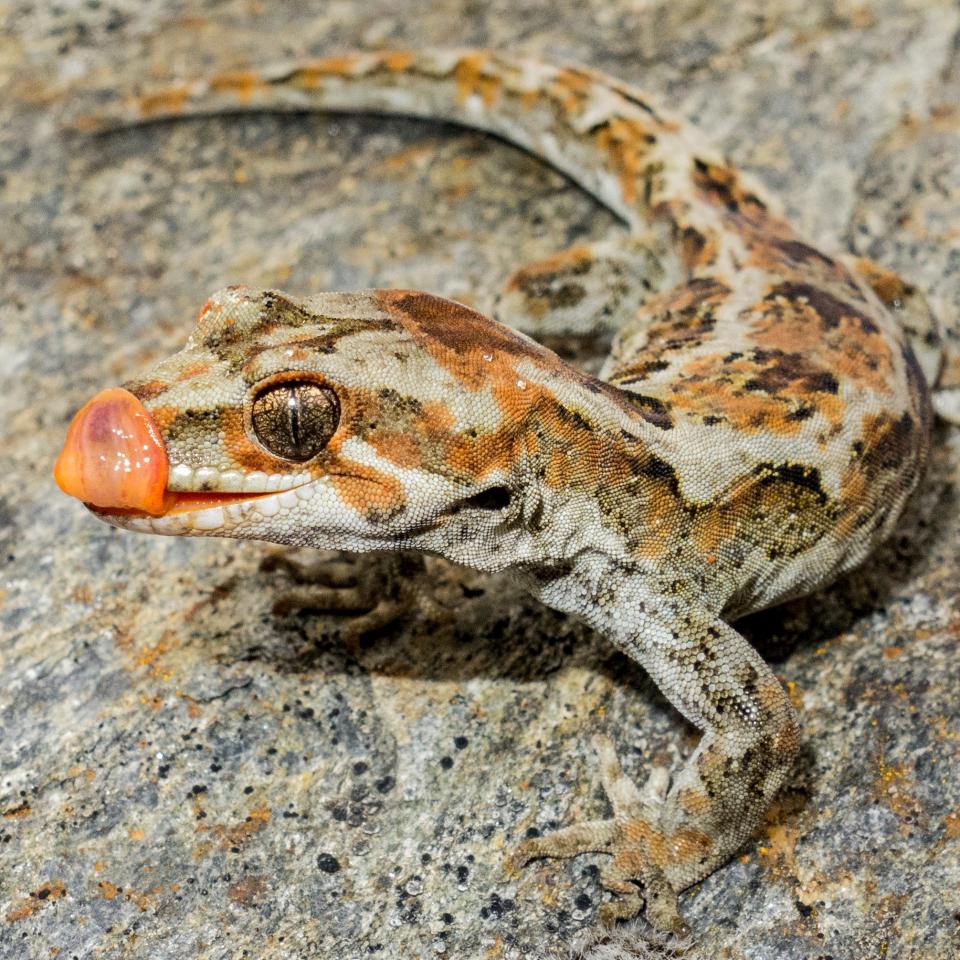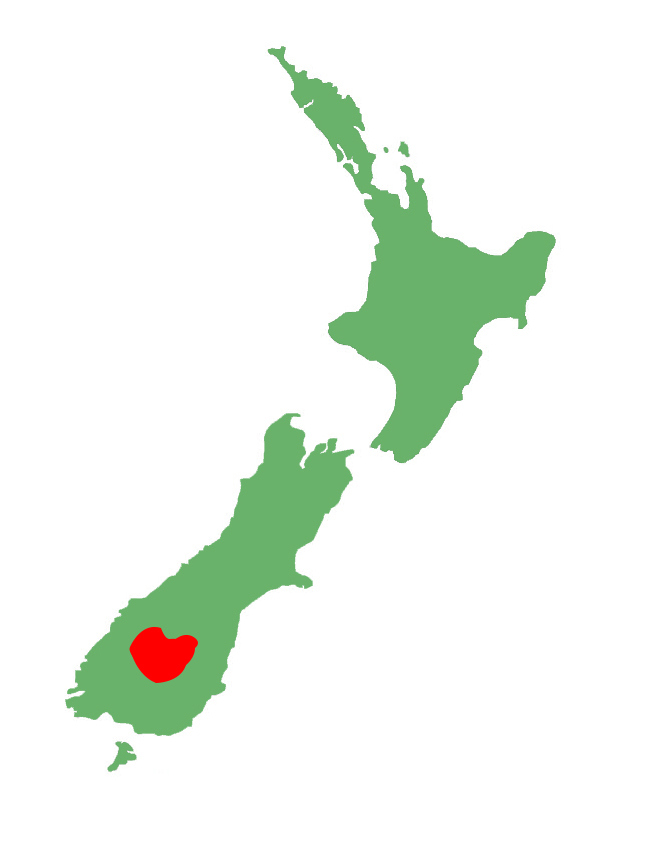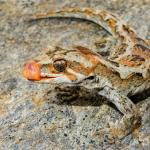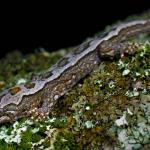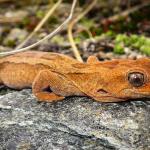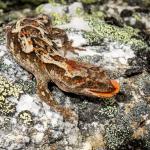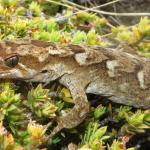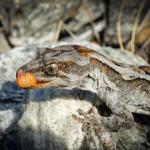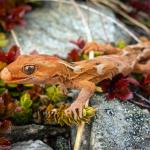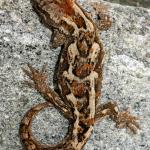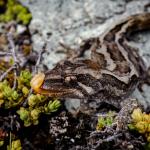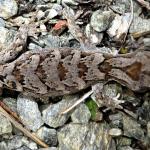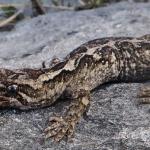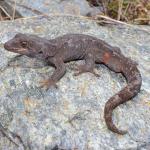- Home
- Herpetofauna Index
- Native
- Mokopirirakau "Roys Peak"
Mokopirirakau "Roys Peak"
Orange-spotted gecko
Mokopirirakau "Roys Peak"
Length: SVL up to 95mm, with the tail being equal to or shorter than the body length
Weight: unknown
Description
A gorgeous species of Mokopirirakau known from the subalpine/alpine zones of the Queenstown-Lakes District. Although named for their orange spotting, some individuals actually lack this feature, either being a drab grey-brown, or occasionally completely orange.
Dorsal surface grey, grey-brown, olive-brown, rusty orange, or pinkish orange with pale blotches, transverse bands, or dorsolateral stripes, which are often edged dark brown or black. Dorsal surface often overlaid with irregular orange, black, brown, or white blotches or spots. A distinctive V-shape marking is typically present on the head behind the eyes. Lateral surfaces typically grey, grey-brown, olive-brown, rusty orange, or pinkish orange, often with pale blotches or dark speckles. The lower portion of the lateral surface is often a more pale grey colour. Ventral surface typically grey or pale orange, often with dark speckles. Interior of mouth and tongue bright orange (van Winkel et al. 2018; Jewell 2008).
Life expectancy
Largely unknown, however, captive Mokopirirakau have frequently been known to live for upwards of 25 years, with some individuals topping the records at 40+ (D. Keal pers. comm 2016). The maximum age for wild animals is not known, however, it is likely that they can live at least as long as captive animals, if not longer.
It is theorised that alpine populations of Mokopirirakau may have longer lifespans than their lowland cousins due to the reduced metabolic activity of these species over extended periods of time. If this is the case it wouldn't be unfair to assume that these species could live well into their 80s, or even reach ages in excess of 100 years.
Distribution
Known from mountainous areas within Central and West Otago such as the Richardson Mountains, Crown Range, Hector Mountains, Dunstan Mountains, Harris Mountains.
Ecology and habitat
Orange-spotted geckos are currently only known from subalpine areas 1100-1800 metres a.s.l. They inhabit boulderfield, tallus, rocky herbfield, rocky tussockland, scree slopes, and rock outcrops. This species is thought to be primarily nocturnal, however, diurnal behavior, such as basking, has been observed (Bertoia et al. 2021). Interestingly, orange-spotted geckos are remarkably cold-tolerant and have been observed emergent on nights with sub-zero temperatures. Despite this, they appear to retain similar body temperatures to lowland gecko species during summer (Bertoia et al. 2021). This, paired with a handful of potential low-elevation sightings of this species may indicate that orange-spotted geckos once occurred in lowland habitat. Additionally, the closest relative of the orange-spotted gecko is the Tautuku gecko (Mokopirirakau "southern forest") (Neilsen et al. 2011), which is a lowland forest dwelling species. It is possible that orange-spotted geckos still exists in beech forest, as this species is highly cryptic and no reliable survey method has been developed for mature beech forest.
Social structure
The orange-spotted gecko is solitary in nature, although they may on occasion share refugia with other individuals. As is the case with other Mokopirirakau it is theorised that males likely show aggression to other males during the breeding season. Neonates (babies) are independent at birth.
Breeding biology
As with all of Aotearoa's gecko species, the orange-spotted gecko is viviparous, giving birth to one or two live young biennially (once every two years) in October/November. Mating in Mokopirirakau may seem rather violent with the male repeatedly biting the female around the neck and head area. Sexual maturity is probably reached between 1.5 to 2 years as with other Mokopirirakau, however, it may take up to 4 years in some of these alpine species.
Diet
They are primarily insectivorous in nature, but are thought to feed on the nectar, and small fruits of several subalpine plant species when they are seasonally available. Being terrestrial in nature, their invertebrate prey tends to be predominantly composed of moths, spiders, weta, and other invertebrates that live in the alpine environments
Disease
The diseases and parasites of Aotearoa's reptile fauna have been left largely undocumented, and as such, it is hard to give a precise determination of the full spectrum of these for many species.
The orange-spotted gecko, as with other Mokopirirakau species, is a likely host for at least one species of endoparasitic nematode in the Skrjabinodon genus (Skrjabinodon poicilandri), as well as at least one strain of Salmonella. In addition to this, it is known to be a host for at least one species of ectoparasitic mite - potentially Neotrombicula naultini as this species is known to occur on other members of the Mokopirirakau genus.
Wild Mokopirirakau have been found with Disecdysis (shedding issues).
Conservation
Prior to 2021, DOC classified this species as 'nationally vulnerable. Accordingly, extensive monitoring was and continues to be undertaken in an attempt to learn more about this species. In 2021 after extensive surveys, the threat status was downgraded to "At Risk - Declining". Orange-spotted geckos do not appear to be at any immediate risk of extinction, and although it is possible that their known habitat is relictual, the species is still relatively widespread.
Interesting notes
The orange-spotted gecko gets its common name from the orange markings that cover their dorsal surfaces (although this isn't present on every individual). The TAG name references their first known locality - Roy's Peak.
"Moko-piri-rakau" is the Maori name for forest gecko, and means 'lizards that clings to trees.'
The orange-spotted gecko, along with its sister taxon (the Tautuku gecko) sit within the Southern clade of the Mokopirirakau genus, with the Tākitimu gecko and cloudy gecko being their closest relatives within the group.
References
Jewell, T. 2008. A photographic guide to reptiles and amphibians of New Zealand. Auckland: New Holland.
van Winkel, D., Baling, M., Hitchmough, R. 2018. Reptiles and amphibians of New Zealand – a field guide. Auckland university press, Auckland New Zealand.

